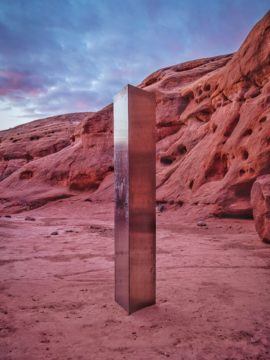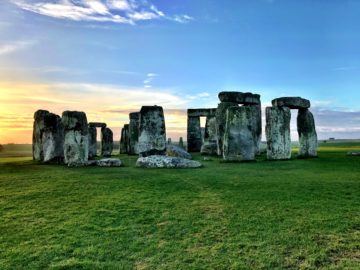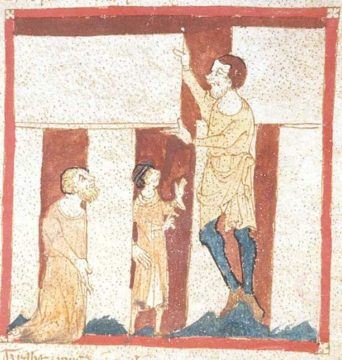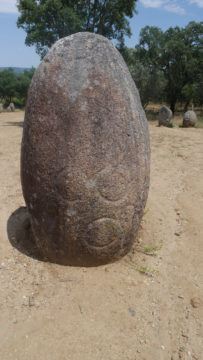by Jochen Szangolies

In November 2020, an odd news item cut through the clouds of pandemic-induced haze with a sharp metal edge: way out in the Utah desert, a strange monolith had been found, a three-sided metal prism (and hence, not quite aptly called a ‘monolith’, with ‘-lith’ coming from Greek líthos, meaning ‘stone’). Subsequent comparisons of satellite imagery of the area revealed that it must have been set up sometime between July and October 2016, having remained unnoticed since—which means that, in an age where few people can do so much as have coffee without immediately informing the whole world via various social media channels, somebody (or -bodies) drove out into the middle of the Utah desert, dragging power tools and sheet metal with them, and assembled the 3m-tall structure, all without apparently telling a single soul. Even the monolith itself bears no identifying marks—no artist’s signature, no fabricator’s stamp, nor any cryptic symbols or a message on how to ‘guide’ humanity after the apocalypse.
Encounters with objects such as the Utah monolith have a slightly uncanny quality. All of a sudden, the natural structure of the landscape is punctuated by clear lines signaling something artificial—something, we expect, that has a purpose, something created towards some end. Something made, as opposed to something grown, or otherwise the product of natural forces. Something that exemplifies a certain design.
The Utah monolith teases all this, but refuses to provide any answers—and thus, it embodies an element of the absurd: a work with no purpose, a means directed towards no discernible end. Some anonymous creator has expended considerable effort for no apparent reason other than to put a metal column in a place where few, if any, would ever see it, and has left us no clue as to their motivation, no means to wrap our heads around the sheer implausibility of the thing’s jutting right out of the bedrock, wedging itself into the world and our minds like a knife between the ribs.
Should we then just chalk this up to the random whim of some eccentric? To a long prank, played at the expense of whoever might eventually chance upon it? Was the creator just driven by the same sense of impishness that makes people strap boards to their feet to trample down crops, creating circles some take for evidence of alien visitation?
I think this is too simple. The impulse of creating objects such as the Utah monolith is something much deeper, and much more human—indeed, in a way, it is an expression of our shared human experience. Monoliths, and objects like them, represent nothing less than a toehold of being in the world. They’re a testament to the fact that whoever carved and placed them was, like you, faced with the impossible task of trying to make sense of it all, to make meaning in a meaningless world, to not be overwhelmed by the absurdity and anxiety of existence. They tell us: I, too, struggled; I, too, hoped, and dreamed, and despaired. Let me try to unpack what I mean by this.
Philosophers’ Stones

Around the world, we are faced with examples of megalithic structures: menhirs, cromlechs, henges, dolmen, the moai of Rapa Nui or Costa Rica’s stone spheres—‘megaliths’ for short. For one reason or another, a wide variety of cultures saw fit to expend substantial effort and resources to quarry great rocks, transport them over sometimes considerable distances, and arrange them according to various designs. Often, the creation of these monuments represent feats of engineering so awesome that alien visitors or lost advanced civilizations have been invoked by means of explanation.
While efforts to recapitulate these feats in modern times, using only the technologies available to the original creators, have shown that one need not appeal to such exotic hypotheses, the essential mystery nevertheless remains: why would anybody undertake these efforts to stick up a few stones? What purpose is served thereby? Life back then, one imagines, was hard enough without hauling huge rocks around, lacking modern amenities like flush toilets and Saturday night TV; why invest all that time and work?
To be sure, theories of these structures’ purposes abound. Stonehenge alone has attracted speculation for hundreds of years, and has variously been considered a place of ritual burial (or even druidic sacrifice), a celestial observatory, a center for healing, or even a prehistoric concert hall.

Incidentally, one of my favorite theories is the one put forward by science writer Lynne Kelly in her 2015 monograph, Knowledge and Power in Prehistoric Societies: she proposes that pre-literate cultures relied, for the cultural transmission of knowledge, on a sort of variant of the ‘method of loci’ for memory-preservation—tying places to specific items of information. On a nomadic lifestyle, these could be places visited during different times of the year, which then physically embodied the link to the necessary items of knowledge. However, once such societies settle down, they need a means to still store and retrieve such information; that means, Kelly argues, is given by the arrangement of stones in megalithic monuments, ‘standing in’ for various features of the landscape.
Stonehenge, and other megalithic sites, may indeed have had any or all of these uses, at various points during its 5000-year history. But I think that, at their base, there is something else that unites them, and that something speaks deeply to our shared experience as human beings, conscious entities, in the world, able to grasp it, reflect on it, and on our place within it.
These Are The Voyages
Imagine that, at some point in the far future, you’re part of an intrepid crew of explorers tasked, we might posit, with a five year mission to explore strange new worlds, to seek out new life and new civilizations, and all that. Yous is the first vessel to reach a new solar system with a promising, rocky planet not too close and not too far from its sun. You park your spaceship in orbit, and begin surveying its surface.
However, news are disappointing: the planet seems entirely devoid of any higher forms of life, to say nothing of civilization. Your scans show nothing but some off-coloured shrubbery, weird fungoid trees, perhaps a few odd fish and skittering bug-things. A treasure trove for the xenobiologists, to be sure, but a dud in terms of making first contact.
But now, suppose that just as you’re preparing to leave, warming up your warp engines and plotting a course for the second star to the right, some unassuming scanner sets off a tiny ‘ping’—which soon is translated into the presence of some structure on the planet. Your science officer isn’t sure, exactly, what it is, but it doesn’t seem to be a natural formation—so, with some excitement, you assemble a landing party, and beam down.
What you find is a strange rock formation—perhaps something not entirely unlike Stonehenge, a complex assembly of stones, or just a single standing stone, implausibly erect against the alien sky. Your science team commences their investigations—taking measurements, noting down its dimensions, mass, approximate age, checking for any signs of advanced technology—radio waves, radiation emanating from the stone, signs of having been cut by powered tools, and the like.
However, there doesn’t seem to be anything to the monument beyond its sheer existence—no trace of its builders, no sign of advanced technology, just stone, roughly hewn with manual tools, set upright, it appears, by nothing but muscle power, levers and pulleys. There is no clear indication of its purpose, no definite use to the structure; it’s just standing there.
At first, you are disappointed, again; the structure refuses to give up its secrets, it seems. But then, you reflect on how its discovery has completely transformed your appraisal of the entire planet, and its history: once, you now know, it must have been a nexus of intelligence, of culture. There were once thinking, feeling beings on the surface of this world, perhaps marveling at the same stars you have descended from.

Megaliths, whatever else they are, are examples of what one might call worked objects: objects that bear the signs of clear artificiality, of tool-use, of design. As such, they must have appeared in a certain way to their creators: as plans, as processes, and finally as finished works. They then embody this very appearance—the fact that, here was somebody to whom the world could appear in a certain way, a conscious, experiencing intelligence, a point of view on the world. The megalith is an enduring sign of its creators’ experiential manifold, an appearance or phenomenon made concrete. It is a particular instance of being in the world (Heideggerian Dasein) cast in stone.
This is the message that the stones transmit to you: not something about their utility, or purpose, but something about their creators—that they themselves were beings capable of finding purpose, of reflecting on the world, of having the world appear to them as something to be worked—as object of their action. They represent tangible evidence of their self-experience as subjects, as agents in the world, trying to find their way.
And I believe that this is the true reason for the existence of such structures. They may have served other, more mundane purposes—a calendar, a mnemonic device, a place of ritual gatherings—but their true purpose is to serve as a mark of their creators’ particular being, and of their awareness of this being. Even of their awareness of existence as something exceeding their own particular lives: stone endures, far beyond the confines of each individual’s existence. Thus, the creators of these monuments must have had a concept of existence as extending beyond themselves, of the existence of a world as independent of them, which only appears in their experience for a brief sliver of time. A megalith, or a similar structure, is, then, a testament to the fact that there was once a particular perspective on the world here.
Suppose that, instead of the stone structure, you had found, say, a road, or housing of some kind. These structures wear their purpose on their sleeves, and are thus easily seen to be the fruits of mere necessity, ‘just’ a more complex iteration of the same feedback loop that makes the badger dig its burrow and the swallow build its nest. But with a megalithic structure, the opacity of their purpose forbids such an immediate explication. Indeed, we may easily suppose that their purpose was vague even to their creators. Perhaps somebody stood up a stone, for no other reason than that they wanted to; then somebody else stood up another, perhaps bigger one (we are all the products of millions of years of competition, after all). Generations hence, a structure has grown, and has attracted all sorts of purposes—perhaps the alignment of those stones allows one to pinpoint the date of the harvest; perhaps their acoustic properties make them uniquely suited for communal festivities; or what have you.
Neither of these, however, would be the ultimate reason for the structure. Rather, it has grown from nothing but an act of sheer defiance, a refusal to be subservient to the strictures of mere necessity, to just exist, until even that ends. A plea to be more than a brief thread of causality woven into the tapestry of the universe.
Erecting that first stone is an authentic choice that doesn’t reduce to necessity or external expectations. Purpose then congeals around this act of radical freedom, in Sartre’s terminology, but does not subsume it. Megalithic structures thus embody the existentialist credo that existence precedes essence: like us ourselves, they are not made for a purpose; rather, their purpose must be found, or crafted.
Whatever drove the setting of the first stone is not the same as the instinct that makes the juvenile mind carve their name into the bark of trees overshadowing them in both size and dignity; nor is it the grandiose attempt to outlast death by means of a monument, like Ozymandias’ statue crumbling in the desert. On the contrary, it is, rather, the acknowledgment of one’s own finitude, a monument not to the individual, to the person, but to the enduring puzzle of existence, to our shared way of being as thinking, feeling, experiencing creatures.
Big Dumb Objects and Small Clever Beings

Encounters with inexplicable artifacts are a staple of science fiction. Often, these are examples of a technology so advanced as to be ‘indistinguishable from magic’, in the phrasing of the doyen of British science fiction, Arthur C. Clarke. A particular noteworthy subspecies is what critic Roz Kaveney has christened the ‘Big Dumb Object’, or BDO: objects that impress themselves upon those that encounter them by their sheer physical implausibility, typically in size, as well as their unfathomable purpose. BDOs are closely connected to the Kantian notion of the sublime, the experience of a greatness beyond any capacity to grasp it, and the terror and awe it engenders.
Not all BDOs have to be physically huge. What they need is, rather, a certain imposing quality, that reflects back on our hapless selves the confrontation with our own insignificance. As such, the famous monolith from the Kubrick-directed, Clarke-written 2001: A Space Odyssey is an almost canonical example of the type. In the film, the monolith presages moments of transformation, most significantly, the transition from ape to human—as signified by a group of apes learning to use bones as tools, or weapons, to drive away a rival group.
In 2001, the monolith is an artifact of technology, and presumably, that technology is instrumental in the apes’ awakening—perhaps it sends out a kind of noetic rays that spark the fire of reflective consciousness within them. But it is also possible that it need not do anything to accomplish that task, but simply exist—that its mere being is the signal that ‘informs’ (in an Aristotelian sense of ‘giving an organization to’) the ape’s brain of the possibility of thinking the world as object, of apprehending it, and thus, working on it—making it the object of one’s actions.
The megalith as a created artifact carries within itself the possibility of creation—sending a message that it is possible to make things, to work parts of the world into shapes suitable to achieving certain aims. It implies the existence of tools, and with them, of the mode of experience that goes along with tool-use—the Zuhandenheit, ready-to-hand-ness, discussed in last month’s column.
The creation of a megalith is then the creation of a BDO—one that does not enter into our sphere of experience from some unfathomable outside, from regions beyond the stars, but from the unexplored reaches of being within each instance of it—that is, within each of us, each particular individual. This is what unites us—the experience of being the ‘single individual’ that, in the words of Kierkegaard, ‘fights for himself with himself within himself’.
To create a megalith, a BDO, is then to create a monument, not to the self, but to the experience of self-hood within all of us, and to acknowledge both the insignificance of each particular instance of being—for that is what the BDO signifies—and the recognition that our shared humanity lies in precisely this insignificance. It is a quintessential act of being—of experience, of consciousness, of ‘what it’s like to be’-ness—manifested in the physical world.
Thus, a site such as Stonehenge might have been a calendar, a ritual site, or a mnemonic device—but also, and I believe moreso, it is petrified being, a colossal invocation of the most elementary formula, ‘I am, as you are’. Like us, its purpose is not given, is not just originally there, but must be crafted. There’s an important lesson here: trying to explain everything in terms of its purpose, its utility, entails an ultimately reductionist view of human endeavor, neglecting the possibility of any real creativity—of any creation that cannot be reduced to its initial conditions, anything that is genuinely novel, rather than a mere unfolding of antecedent data.
